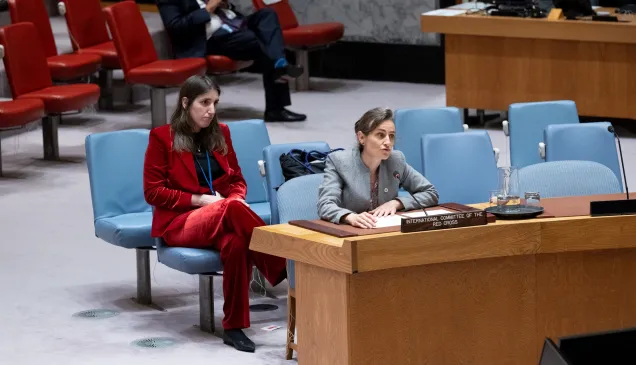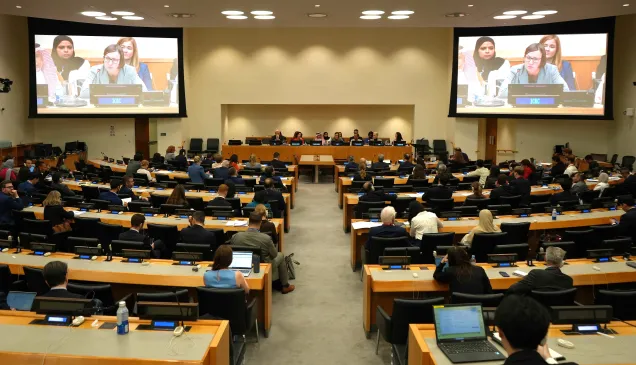Mr Chair, Excellencies, Ladies and Gentlemen,
The International Committee of the Red Cross (ICRC) is grateful for the opportunity to address the First Committee.
Earlier this year, the Secretary-General of the United Nations released his policy brief ‘A New Agenda for Peace’, which outlines his “vision of multilateral efforts for peace and security, based on international law, for a world in transition”. ‘A New Agenda for Peace’ begins with a clear-eyed and unflinchingly realistic assessment of the global security situation we currently face. It highlights geopolitical shifts, the changing nature of armed conflict, increasing violence, erosion of multilateral norms, rising inequality, shrinking space for civic participation and the risks posed by new technologies.
In our work around the world, we see first hand how these evolutions are exacerbating the suffering of victims of armed conflict through the growing risk of the use of nuclear weapons; the terrible impact of war in cities, including the use of heavy explosive weapons in populated areas and the destruction of critical civilian infrastructure; the immediate and long-lasting humanitarian consequences of the use of antipersonnel mines and cluster munitions; concerns over inadequately controlled transfers of arms and ammunition; and the increasingly significant role of advanced technologies, such as cyber, artificial-intelligence (AI) and space-based technologies, coupled with growing levels of autonomy in weapon systems. This reality is something that we, this Committee and the wider international community cannot ignore.
If we are to take effective collective action to address these challenges, then shared humanitarian values and existing international law must form the common ground. To the critically important issues on this Committee’s agenda the ICRC brings its field-based experience as a humanitarian organization working to protect and assist victims of armed conflict and other situations of violence around the world, and its expertise in international humanitarian law (IHL).
Mr Chair,
Nuclear weapons profoundly challenge the basic premises of IHL: weapons capable of spreading radiation across borders and down generations, causing horrific injuries and often untreatable illness, and poisoning the environment for decades – if not centuries – to come are fundamentally incompatible with the principles of distinction, proportionality and, above all, humanity.
In light of their catastrophic humanitarian consequences, it is extremely doubtful that nuclear weapons could ever be used in accordance with the principles and rules of IHL. Any use would be abhorrent to the principles of humanity and the dictates of public conscience. The same applies to any threat – whether irresponsible or soi-disant “responsible” – of the use of such weapons, be it for defensive, deterrent or offensive purposes, using strategic or so-called tactical nuclear weapons.
Today, we are witnessing disturbing developments that risk eroding the decades-long taboo against the use of nuclear weapons. More than 50 years after the entry into force of the Treaty on the Non-Proliferation of Nuclear Weapons (NPT), the risk of nuclear weapons being used is at its highest since the darkest moments of the Cold War. In the face of growing international and regional tensions, nuclear rhetoric has increased alarmingly, and nuclear deterrence theories are regaining vigour. The modernization of nuclear arsenals continues unabated, with the development of smaller nuclear weapons claimed to be more “usable” and intended for tactical military use in combination with conventional capabilities. Despite the commitments made at NPT Review Conferences, the role of nuclear weapons in military doctrines and security policies is, rather than diminishing, actually growing. The ICRC is also extremely alarmed by the suggestion that AI may be introduced into the command-and-control systems of nuclear weapons.
These developments bring us closer day by day to a nuclear catastrophe – whether intentional, due to a miscalculation or accidental. Clearly, they also go against the obligation of NPT States Parties to take effective measures towards nuclear disarmament, and against the many commitments undertaken in past NPT Review Conferences. Nuclear risk-reduction measures and tangible progress towards nuclear disarmament are urgently needed.
The Treaty on the Prohibition of Nuclear Weapons (TPNW), which, so far, has 69 States Parties and a further 28 signatories, has made a significant contribution towards the elimination of nuclear weapons. It prohibits them in an unequivocal and comprehensive manner, given the catastrophic humanitarian consequences of their use. We call on all States to demonstrate their commitment to a nuclear-weapon-free world by joining the TPNW without delay.
The TPNW is an indispensable part of the nuclear disarmament architecture and complements and reinforces other existing relevant instruments, such as the NPT, the Comprehensive Nuclear-Test-Ban Treaty and regional treaties establishing nuclear-weapon-free zones. The ICRC calls on all States to promptly ratify or accede to all these instruments and to discharge their obligations and commitments under these treaties in full.
Mr Chair,
The unconstrained development and use of autonomous weapon systems presents unacceptable humanitarian, ethical and legal risks that the international community must address today. This is why, last week, the Secretary General of the United Nations and the President of the ICRC issued a joint appeal, calling on political leaders urgently to establish new international law with specific prohibitions and restrictions on autonomous weapon systems.
This appeal echoes the recommendations of the United Nations Secretary-General, in his New Agenda for Peace, and of the ICRC’s previous statements before this Committee, in which we emphasized that new rules are needed to preserve human control over the use of force and the effects of weapons. Such control is required by IHL and by moral imperatives.
In our view, States must expressly prohibit unpredictable autonomous weapons, which we understand as systems that prevent users from being able to anticipate and limit their effects, as required by IHL. We are particularly concerned by autonomous weapons, including swarms, that are controlled by machine-learning software that writes its own rules, is not understandable or explainable, and – worse still – might alter its own functioning over time.
This should be coupled with a prohibition against systems designed or used to target humans. As emphasized in the joint statement by the Secretary General of the United Nations and the President of the ICRC, “the autonomous targeting of humans by machines is a moral line that we must not cross”. And from a legal perspective, we find it difficult to envisage a realistic combat situation in which the use of an autonomous weapon system against a person would not pose a significant risk of violating IHL.
Then, for all other systems, there must be a combination of limits on the types of target and on the duration, geographical scope, scale and situations of use, plus a requirement to ensure effective human supervision and timely intervention and deactivation.
Industry, militaries and the general public are increasingly looking to their governments to demonstrate leadership, and to provide clarity on this issue. Over the last year, we have been encouraged by the growing momentum among States towards establishing an effective framework of prohibitions and restrictions.
There have been strong statements from regional groups, in particular across the Latin America and Caribbean region.
Furthermore, after nearly ten years of discussions, the Group of Governmental Experts of the Convention on Certain Conventional Weapons has set out a structure of non-binding prohibitions and restrictions. While that structure could form the basis for new international rules, States must now go beyond merely recalling existing legal frameworks and negotiate a legally binding instrument that establishes clear and specific red lines regarding which autonomous weapons are prohibited and how others must be restricted.
We know that these discussions will be continued in this session of this Committee, and we encourage all States to take bold and principled political action to move to negotiations.
Mr Chair,
Current armed conflicts have demonstrated the growing significance of cyber and other digital threats, and the potential for AI, particularly machine-learning techniques, to increase their scale and severity. Urgent action is required from States and other stakeholders in response to these developments.
The ICRC commends the ongoing discussions in the Open-Ended Working Group on developments in the field of information and telecommunications in the context of international security. We share the concern of States about the continuing increase in incidents involving the malicious use of information and communications technology by State and non-state actors, in particular during armed conflict. In our view, focused exchanges among States on the limits that IHL imposes on such operations are urgently needed. The long-standing rules of IHL only serve their purpose if interpreted and applied in ways that ensure adequate protection for civilians, civilian infrastructure and civilian data in our increasingly digitalized societies. In light of the kind of cyber operations we are currently seeing, interpretations of IHL that focus solely on the protection of civilian objects against physical damage are insufficient.
An additional matter of serious concern for the ICRC is the growing involvement of civilians – individuals, hacker groups and companies – in digital operations related to armed conflicts. The more civilians take part in military operations, and the more civilian infrastructure, such as civilian satellite communication or cloud infrastructure, is used for military purposes, the greater the risk of civilians and civilian infrastructure being targeted. This trend risks undermining the universally supported principle of distinction and must be reversed. To this end, we call on States to stop turning a blind eye to the participation of private hackers in armed conflict. In addition, States and the tech sector should discuss the potential risks that arise when civilian digital infrastructure is used for military purposes, and work towards a common understanding of limits on the military use of civilian digital infrastructure during armed conflicts.
Next week, the ICRC will release a set of four guiding principles and 25 recommendations to protect civilians against digital threats during armed conflicts. These principles and recommendations were developed jointly with leaders and experts from the legal, military, policy, technological and security fields.
Mr Chair,
Recent events have highlighted the rapidly growing and often crucial role that space capabilities and technology play in modern terrestrial armed conflict, as well as the increasing likelihood of these capabilities being attacked. The debates at the Open-Ended Working Group on reducing space threats through norms, rules and principles of responsible behaviours showed the increasing concern of the international community over the continued militarization and possible weaponization of outer space, and the risk of outer space becoming a domain of active hostilities.
Against this backdrop, the importance of reaffirming the applicability of relevant international law – including the United Nations Charter, treaties on outer space, IHL and the law of neutrality, where relevant – to outer space cannot be overstated. Military operations in, or in relation to, outer space do not occur in a legal vacuum but are constrained by existing international law. Notably, the UN Charter, the Outer Space Treaty and IHL prohibit certain military activities in outer space. IHL, in particular, offers protection for the civilian population and civilian objects on Earth against the effects of hostilities in, or in relation to, outer space. Any development of new legally binding rules or voluntary norms must be consistent with, build on and strengthen the existing legal framework.
Furthermore, in light of the specific characteristics of the space environment and the accelerated development of the space sector, the ICRC recommends that States further study and discuss how international law applies in outer space. Clarity on legal requirements and obligations contributes to compliance with international law and helps reduce risks of misperception, miscalculation and unintended escalation.
Damage to, disruption or destruction of space systems serving critical civilian infrastructure and supporting essential civilian services could have significant human cost on Earth and in space. States and militaries must avoid developing or using military space capabilities that cause unacceptable consequences for civilian populations. Humanitarian considerations should also be a cornerstone of any multilateral discussion and of any normative development with regard to space security.
To minimize the risk of civilian harm arising from threats to space systems and to strengthen the protection of civilians from harmful effects of military space operations, concrete measures States can consider include: ensuring the protection of space systems necessary for essential civilian services and specifically protected persons and objects under international law, including by identifying, marking, announcing or otherwise indicating these space systems and, when feasible, by physically or technically separating or segmenting the civilian use of space systems from military use; mitigating the risk of space debris by imposing a moratorium on the development, testing and use of kinetic counterspace capabilities and other harmful operations entailing similar effects; and enhancing international cooperation to increase the resilience of space-based services on which humanitarian relief and emergency response rely.
Mr Chair,
In 2023, the use of anti-personnel minesandcluster munitions has grown alarmingly and casualties have spiked dramatically. Anti-personnel mines and cluster munitions kill and maim indiscriminately and continue to cause widespread human suffering long after conflicts have ended. Any use of these weapons, anywhere, by anyone, must be condemned. To prevent further victims, we urge all States and parties to armed conflicts immediately to stop using, producing, transferring and stockpiling anti-personnel mines and cluster munitions. The Anti-Personnel Mine Ban Convention and the Convention on Cluster Munitions reflect life-saving norms against these treacherous weapons. These norms must be upheld and universal adherence to these instruments promoted.
In addition, efforts must redouble to promote universal adherence to other instruments prohibiting or restricting the use or transfer of conventional weapons and, in particular, to the Convention on Certain Conventional Weapons and its Protocols, and the Arms Trade Treaty. The ICRC calls on all States that have not yet done so to join these instruments without delay.
Widespread availability of and inadequate controls on transfers of arms and ammunition prolong conflicts, drive displacement and negatively affect development goals. States must exert greater diligence in assessing the risks posed by arms exports and implement timely, robust and practical measures that can realistically offset risks of violations. Those who supply the means by which wars are fought assume a special responsibility. They must do everything reasonably in their power to ensure respect for IHL by recipients who are party to an armed conflict. States must refrain from transferring arms where there is a clear risk that these would be used to commit IHL violations. Faithful implementation of the Arms Trade Treaty is a humanitarian imperative and will go a long way in preventing serious violations of IHL.
Mr Chair,
The use of heavy explosive weapons in populated areas continues to be a major cause of civilian harm in armed conflict. Across the globe, ICRC staff witness on a daily basis the suffering and destruction caused by the bombing and shelling of towns and cities. Death, injury, lifelong disability and severe psychological trauma are often the direct results of this deadly choice. Houses, hospitals, schools and critical infrastructure are damaged or destroyed beyond repair; entire neighbourhoods are turned into rubble. The plight of civilians is aggravated when basic services on which they rely for their survival – such as water, electricity, health care or waste management – are disrupted, because a pipe or power station happened to be within the explosive weapon’s wide impact area. Displacement and unexploded ordnance contamination complete the painful reality faced by hundreds of thousands of men, women, boys and girls.
Against this bleak backdrop, last year saw the adoption of the landmark Political Declaration on Strengthening the Protection of Civilians from the Humanitarian Consequences Arising from the Use of Explosive Weapons in Populated Areas. A total of 83 States committed to, among other things, restricting or refraining from the use of explosive weapons in populated areas, where such use may cause civilian harm, and to considering the indirect or reverberating effects, notably on essential services, when planning and conducting military operations. The declaration signals an important shift in mindset, but the real test lies in putting it into practice. The ICRC encourages all States to endorse the political declaration and faithfully implement it, and we look forward to the first conference taking place in Oslo in April 2024.
More broadly, the impact of war in cities is an issue of continued concern for the ICRC and the entire International Red Cross and Red Crescent Movement. The humanitarian impacts of urban warfare are complex and devastating. They are direct and indirect, immediate and long-term, visible and invisible. The destruction caused by conflict in cities can set development indicators back decades. The adverse humanitarian impact of all the weapons and technologies addressed in our statement is often multiplied in urban settings. Given the growing urbanization of the world’s population, the ICRC urges States to focus on the impact of war in cities and develop more effective measures to prevent urban warfare and to protect civilians and civilian infrastructure when urban warfare takes place.
To conclude,
Returning to the grim assessment reflected in ‘A New Agenda for Peace’, the ICRC believes that shared humanitarian values and IHL, together with a strengthening and prioritization of disarmament, provide the basis for States and the wider international community to take effective action to address the pressing challenges the Secretary-General has listed. The multilateral treaties, resolutions, processes and proposals considered by this Committee provide indispensable tools to uphold the protection of civilians affected by armed conflict around the world. We urge all States to embrace, adopt, develop and implement them.
It is precisely for a deteriorating security context, and for growing strategic risks, that multilateral disarmament was conceived. The international community must restore the vision of disarmament as a crucial path towards sustainable peace and security, and we stand ready to continue assisting you in your efforts.
Thank you.




